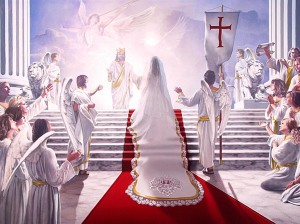 In the previous post we looked at the first aspect of the holiness of our sexuality: it reflects the inseparable oneness and intimacy of the Trinity.
In the previous post we looked at the first aspect of the holiness of our sexuality: it reflects the inseparable oneness and intimacy of the Trinity.
In this post we look at the second and related reason it has been set apart by God:
It has been set apart by God to reflect the eternal covenantal love of the Trinity.
As we mentioned in a previous post the Father has been eternally loving the Son (Jn 17:24) by the Spirit (eg Rom 15:30) and so John declares that “Whoever does not love does not know God, because God is love.” (1 Jn 4:8). So we are created as lovers in the image of God.
However, this love is very different to our concept of love – it is Holy. The aspect of this holy love that we want to look at here is the covenantal nature of His love.
What is a covenant?
The word “covenant” comes from the Latin con venire meaning a coming together. It describes a solemn binding agreement between two parties, where the deity was solemnly invoked as witness (Gen 31:50 ) to the oath that was sworn (Gen 21:31).
It was the most serious form of agreement and breaking a covenant was considered a heinous sin, and often imposed the penalty of death but at the very least there was an understanding that the one who broke the covenant would be cursed[1].
The Hebrew verb “to seal” or “make” a covenant karath (כָּרַת), translates literally as “to cut”, hence you cut a covenant. That is because the parties were usually bound together usually by a blood sacrifice with a celebratory feast afterwards.
The tradition the Hebrews used was to cut an animal in two and then have both parties pass between the two parts (Gen 15:8-21; Jer 34:18-19). It is suggested that they are saying “May I be torn apart like these animals if I fail to uphold my part of this covenant.”
Afterwards the parties would eat the meat together in a meal (Gen 26:30; 31:54).
The cutting was the oath sign (a symbolic and specific act that seals the deal) but sometimes an additional sign or witness to the covenant was given. For example a pillar of stones (Gen 31:52).
So in summary, the components of a covenant were the oath where God was invoked as witness, the oath sign and the meal together.
Covenants between God and mankind
This most binding form of agreement was the one God chose to enter into with man. He makes oaths with man (eg Dt 4:31) where He swears by Himself (eg Gen 22:15; Heb 6:13-17) and confirms it with a sacrifice (eg Gen 15:17-18; Ex 24:8; Matt 20:28) or other oath sign (eg Rainbow Gen 9:12-13) and a meal together (eg Ex 24:9-10). Since God is eternal and a covenant last until the death of the parties the covenants He makes are everlasting (eg Gen 9:16; 17:7).
And yet despite us repeatedly breaking God’s covenants of love (Dt 7:7-9; Neh 1:5; 9:32) He does not change his mind (1 Sam 15:29) and is faithful when we are faithless as he cannot disown himself (2 Tim 2:13).
Marriage is a covenant
Since we are made in the image of God (Gen 1:27) we are created as covenantal lovers[2] and marriage is a prophetic declaration of the Trinitarian love. However if we want to truly understand marriage then, like Jesus did (Mt 19:4), we need to go back to the beginning.
Adam and Eve were married (see Gen 3:8; 4:1) and we see in the bible that marriage is a covenant:
“It is because the LORD is the witness between you and the wife of your youth. You have been unfaithful to her, though she is your partner, the wife of your marriage covenant.” (Mal 2:14b)
So Adam made his covenant oath in the presence of God and later Jewish marriages were performed under the chuppah[3] (חוּפָּה) as a sign of God’s presence hovering over His people[4].
Like the other covenants we have referenced it held until the death of one of the parties and hence there was no divorce:
Jesus replied, “Moses permitted you to divorce your wives because your hearts were hard. But it was not this way from the beginning” (Mt 19:8)
And had Adam and Eve not have eaten from the tree of the knowledge of good and evil, then their marriage covenant would have also been eternal like the Father’s eternal love for the Son.
What is the sign of the marriage covenant?
It was the consummation. This is why Jewish marriages were not considered complete until consummation, and only after that would the seven days of feasting begin.
This is why when blood was spilt by a broken hymen upon consummation it was understood to be the blood of the covenant they had just made.
Hence, thereafter lovemaking[5] is a reminder of that marriage covenant in the same way a rainbow is a reminder of God’s eternal covenant with Noah (Gen 9:16)[6].
So the marriage covenant is symbolic of the eternal oneness and covenantal love of the Father for the Son. The covenant joining as we saw in the last post is by God Himself (Mt 19:6) and the blood covenant represents the sacrificial act that is necessary for this to remain so. Hence because the marriage between a man and a woman is one of the highest prophetic declarations of the nature of God:
“Marriage should be honoured by all, and the marriage bed kept pure, for God will judge the adulterer and all the sexually immoral” (Heb 13:4)
This is why God hates divorce (Mal 2:16a) and why he won’t receive the offerings and prayers of a man who breaks faith with his wife (Mal 2:13-14) or who does not treat her with respect (1 Pet 3:7) as he is profaning the image of God[7] . How can a man say he loves God if he does not love his wife (cf 1 Jn 4:19-21)?
What is our covenantal marriage oath of love like?
Well we can’t define our own terms as that would be setting up our own image of God. So we need to know what the love of the Father for the Son looks like and what Son’s love for the Father is. But since God’s ways and thoughts are higher than ours (Isa 55:8-9) we can’t even begin to fathom. But Jesus shows us what that love looks like as He said “As the Father has loved me, so have I loved you” (Jn 15:9a) and Jesus’ love for the Father was shown by his sacrifice (Jn 14:31a):
“Jesus knew that the Father had put all things under his power, and that he had come from God and was returning to God; so he got up from the meal, took off his outer clothing, and wrapped a towel around his waist. After that, he poured water into a basin and began to wash his disciples’ feet, drying them with the towel that was wrapped around him.” (Jn 13:3-5)
“Greater love has no one than this: to lay down one’s life for one’s friends”. (Jn 15:13)
This kind of love isn’t like how the world loves (see also Mt 20:25-28; 5:44-45) but we are to be holy like our God is holy (1 Pet 1:15-16; Lev 11:45; 20:26). Our God makes the sun shine on the evil and the good (Mt 5:45), he loves us even though we didn’t love him (1 Jn 4:10), and sent his son to die in our place (1 Pet 3:18) while we were still sinners (Rom 5:8) and His enemies (Rom 5:10). He now calls us His friends (Jn 15:15) and adopts us as his children (Jn 1:12) and makes us fellow heirs with Christ (Rom 8:17) with Christ’s righteousness (2 Cor 5:21).
And so the marriage vows are about lifelong sacrificial giving and laying down our life for the other not a demanding that the other person satisfies my needs. Hence:
“Any attempt to define love in the context of what the other person does or doesn’t do violates God’s definition of love as well as the vows you spoke on your wedding day.” (Tim Alan Gardner).
This is why Paul says that “Husbands, love your wives, just as Christ loved the church and gave himself up for her” (Eph 5:25).
I, N , take you, N , to be my wife, to have and to hold from this day forward; for better, for worse, for richer, for poorer, in sickness and in health, to love and to cherish, till death us do part; according to God’s holy law. In the presence of God I make this vow.
Heavenly Father, by your blessing let these rings be to N and N a symbol of unending love and faithfulness, to remind them of the vow and covenant which they have made this day through Jesus Christ our Lord.
N, I give you this ring as a sign of our marriage. With my body I honour you, all that I am I give to you, and all that I have I share with you, within the love of God, Father, Son and Holy Spirit.
[1] Hence the stoning of those who broke the covenant and also the curses listed for those who broke the covenant.
[2] Hence we are to be like Him “Be Holy because I am Holy”
[3] This was a rectangular piece of material, often the Jewish prayer shawl (tallit from Num 15:38).
[4] Certainly marriages weren’t originally performed in the tabernacle or temple as Jews understood that God was present everywhere.
[5] Though technically you don’t make love you celebrate your covenant of love.
[6]Thank you to Tim Alan Gardner and his book “Sacred Sex” that first opened my eyes to this.
[7]This is why homosexuality is akin to idolatry (Rom 1:22-27) as it is setting up a different image of God to the true one presented in Genesis.

[…] saw in our previous post that marriage is an exclusive covenant relationship between a man and a woman which reflects the […]
LikeLike
[…] that sexual intercourse is holy as it reflects the oneness and intimacy in the trinity, it is the seal of the marriage covenant and it points to the ecstasy of our future union with […]
LikeLike
[…] holiness is the fact that this fulfillment occurs in a covenantal relationship and this yearning is a shadow of our yearning for Christ (Eph 5:32) who is the “desire of all […]
LikeLike
[…] teaching godly sexuality – we affirm it’s goodness and we affirm its holiness (and also here and […]
LikeLike
[…] in Gen 2 – one man, one woman, one flesh, joined together (literally glued) by God in a lifelong covenant (Mal 2:14) and no man should ever separate what God has joined together! (Mt […]
LikeLike